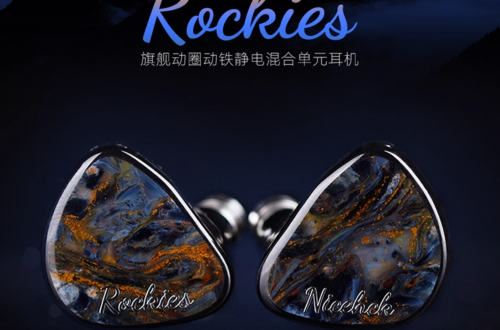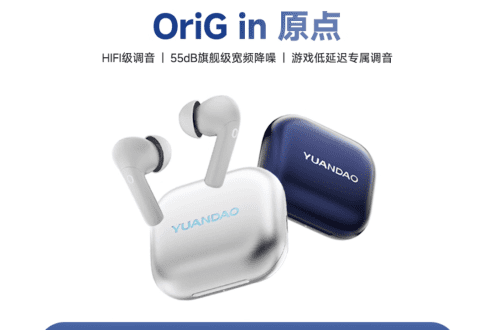HIFI Diary: NICEHCK Octave Portable DAC Sound Quality Quick Review
I. Preface
Recently, the BLOG owner has almost had enough of listening to the 43131. Fortunately, this review is a bit different—it’s probably the first (or one of the very few?) dongle DACs featuring the ES9039Q2M chip. Finally, after moving away from the 43131/43198, the dongle DAC market is seeing something fresh. The BLOG owner recently reviewed the Yuandao Rockies electrostatic hybrid flagship earphones, and honestly, the listening experience wasn’t great. Hopefully, this return to the budget segment can help restore Yuandao’s image in the BLOG owner’s mind. 😄
II. Preparation for the Review
The product under review is the Yuandao Octave dongle DAC. It is compared with the BLOG owner’s previously reviewed best-value dongle DAC, the Lao Ban Zhang LBZ-04, as well as the recently reviewed Sound Memory SA500. The test setup includes a Xiaomi 13 Ultra + QQ Music/Yinliu, connected to the phone using the Octave’s original cable. The test earphones are the BLOG owner’s daily drivers, the flagship-level Yin Chao Technology XY0, with both earphones using the 4.4mm balanced interface.
III. Assessment Tracks/Scoring Method
The track selection is based on the blogger’s usual listening preferences, which are about 50% ACG music, 30% modern music, and 20% classical music. Therefore, the selection leans heavily towards Japanese music. The scoring criteria are derived from a simplified version of Liu Hansheng’s “Twenty Essentials for Audio,” with a maximum score of 10, though generally, the highest score given is 9. A score of 8 indicates a clear advantage in the scoring category, 7 signifies excellence, 6 means it can be normally appreciated, 5 means it can be normally listened to, and scores below 5 are not commented on. For a more detailed evaluation plan, please refer to here.
IV. Testing Begins
| Item | Da Mo Ju | LBZ-04 | SA500 | MUB1 | DS1 | LUNA | Octave |
|---|---|---|---|---|---|---|---|
| Integrity | 8.5/10 | 7/10 | 7/10 | 6.5/10 | 6.5/10 | 6.5/10 | 7.5/10 |
| High frequency | 8/10 | 6.5/10 | 6.5/10 | 7/10 | 5.5/10 | 5.5/10 | 6/10 |
| Medium frequency | 8/10 | 6.5/10 | 6.5/10 | 6.5/10 | 6/10 | 6/10 | 6.5/10 |
| Low frequency | 8/10 | 6.5/10 | 6.5/10 | 6.5/10 | 6.5/10 | 5.5/10 | 7/10 |
| Analysis, separation | 7.5/10 | 7/10 | 7/10 | 7/10 | 7/10 | 5.5/10 | 7/10 |
| Sound field, density | 8/10 | 6/10 | 6/10 | 7/10 | 6/10 | 5.5/10 | 6/10 |
| Drive, dynamic | 8/10 | 6.5/10 | 6.5/10 | 7/10 | 7/10 | 5/10 | 7/10 |
| Total score | 8/10 | 6.6/10 | 6.6/10 | 6.8/10 | 6.4/10 | 5.6/10 | 6.7/10 |
V. Summary
This is indeed a refreshing dongle DAC product. The Octave’s companion app has a clean and user-friendly design, but it lacks features and initially couldn’t lock the volume level, requiring adjustments every time the earphones were plugged in (this has been fixed). This made it feel a bit immature. However, sound quality is ultimately the most important aspect of a dongle DAC. First and foremost, its technical performance is solid, and its sound signature stands out from the common 43131-based dongles. The BLOG owner was particularly impressed by its dynamics, resolution, bass, and driving power. The vocals are relatively forward, with accurate imaging, and it doesn’t suffer from the harshness often associated with the 90X8 series in compact devices. The Octave also inherits the traditionally firm and robust sound characteristic of the 90X8/90X9 family. When listening to songs that emphasize emotional nuances in vocals, it might have a slight disadvantage compared to many 43131-based dongles. However, in the vast majority of genres (including pop, rock, jazz, and classical), the Octave’s superior technical performance gives it a clear edge. Compared to another dongle using a 90XX series DAC, the DS1, the Octave’s sound is noticeably more refined and natural, without being overly rigid—a very commendable achievement.
Of course, the Octave isn’t without its flaws, and these are worth discussing in detail. First, the high frequencies: the Octave has good extension and clarity in the highs but can be slightly piercing, with noticeable sibilance in some tracks. Since preferences for high-frequency presentation vary, the BLOG owner ultimately feels the Octave’s treble is a bit overdone. Next is the midrange, which is the most debated aspect. There’s no denying that in midrange vocals, especially male vocals where detail is crucial, the Octave lacks some emotional depth and fullness. However, after repeated listening, the BLOG owner believes the Octave’s midrange isn’t flawed—it’s just very neutral, neither warm nor cold. The BLOG owner specifically tested it with several vocal-focused tracks and found no major issues. Therefore, unless you primarily listen to artists like Cai Qin (蔡琴) or Teresa Teng (邓丽君), who emphasize breathiness and emotion, the Octave’s vocal performance is actually quite versatile. Lastly, the soundstage, which is important for classical music, is relatively small on the Octave, with limited depth. However, for chamber music, its accurate tonality and detail retrieval provide a satisfying experience. Considering its price, the limitations with large-scale orchestral works are entirely acceptable—it’s already plenty good.




